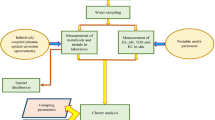Abstract
Wetland sediments are generally considered as a sink for metals and, in the anoxic zone, may contain very high concentrations of heavy metals in reduced state. A comprehensive study was carried out to compare the differences of total, environmentally available (Env-Av), HOAC, EDTA and DTPA available heavy metal fraction in tailing of the marshy area of a copper tailing pond and the dry tailing. The average concentrations of all the seven metals in the wetland tailing were found higher than dry tailing. Regarding pH, organic carbon, availailable N, P and K also found higher in marshy wetland tailing compare to the dry tailing. This information is needed in order to understand wetland system and to assure that wetlands do not themselves eventually become sources of metal contamination to surrounding areas. But as levels of pollutants increases, the ability of a wetland system to incorporate waste can be impaired and the wetland can become a source of toxicity.
Similar content being viewed by others
Reference
Baziramakenga, R., Siomard, R. R., & Leroux, G. D. (1995). Determination of organic acids in soil extracts by ion chromatography. Soil Biology & Biochemistry, 27, 349–356.
Bray, R. H., & Kurtz, L. T. (1945). Determination of total, organic, and available forms of phosphorus in soils. Soil Science, 59, 39–45.
Cieslinske, G., VanRees, K. C. J., Szmigielska, A. M., Krishnamurti, G. S. R., & Huang, P. M. (1998). Low molecular weight organic acids in rhizosphere soils of durum wheat and their effect on cadmium bioaccumulation. Plant and Soil, 203, 109–117.
Das, M., & Maiti, S. K. (2007). Metal accumulation in A. baccifera growing naturally on abandoned copper tailings pond. Environmental Monitoring and Assessment, 127(1–3), 119–125.
Deb, M., & Sarkar, S. C. (1975). Sulphide ore bodies and their relation to structure at Roam-Rakha mines-Tamapahar sections, Singhbhum copper belt, Bihar. Recent Researches in Geology, 2, 247–264.
Galiulin, R. V., Bashkin, V. N., Galiulina, R. R., Kucharski, R., Malkowski, E., & Marchwinska, E. (1999). The impact of phytoextraction effectors on the enzymatic activity of soil contaminated by heavy metals. Agricultural Chemistry, 3, 243–251.
Gambrell, R. (1994). Trace and toxic metals in wetlands — A review. Journal of Environmental Quality, 23, 883–891.
Gupta, P. K. (2000). Chemical methods in environmental analysis: Water, soil and air (pp. 240–241). India: Agrobios.
Houba, V. J. G., Lexmond, T. H. M., Novezamsky, I., & Van der Lee, J. J. (1996). State of the art and future developments in soil analysis for bioavailability assessment. Science of the Total Environment, 178, 21–28.
Leschber, R., Davis, R. D., & Lhermite, P. (1985). Chemical methods for assessing bio-available metals in sludges and soil. London: Elsevier.
Lindsay, W. L., & Norvel, W. A. (1978). Development of a DTPA soil test for zinc, iron, manganese and copper. Soil Science Society of America Journal, 42, 421–428.
Lopez-Sanchez, J. F., Sahuquilo, A., Rauret, G., Lachica, M., Barahona, E., Gomez, A. et al. (2002). Extraction procedures for soil analysis. In P.H. Quevauviller (Ed.), Methodologies in soil and sediment fraction studies: Single and sequential extraction procedures (pp. 28–65). Cambridge, UK: Royal Society of Chemistry.
McGrath, D. (1996). Application of single and sequential extraction procedures to polluted and unpolluted soils. The Science of the Total Environment, 178, 37–44.
Moorhead, K. K., & Reddy, K. R. (1988). Oxygen transport through selected aquatic macrophytes. Journal of Environmental Quality, 17, 138–142.
Nelson, D. W., & Sommers, L. E. (1982). Total carbon, organic carbon and organic matter. In A.L. Page (Ed.), Methods of soil analysis, Part 2. Chemical and microbiological properties (2nd ed., pp. 539–579). Madison, WI: American Society of Agronomy.
Novozamsky, I., Lexmond Th. M., & Houba V. J. G. (1993). A single extraction procedure of soil for evaluation of uptake of some heavy metals by plants. International Journal of Environmental Analytical Chemistry, 51, 47–58.
Pomeroy, L. R. (1970). Strategy of mineral cycling. Annual Review of Ecology and Systematics, 1,
Subbiah, B. V., & Asija, G. L. (1956). A rapid procedure for the determination of available nitrogen in soils. Current Science, 25, 259–60.
Tessier, A., Cambell, P. G. C., & Bisson, M. X. (1979). Sequential extraction procedure for the speciation of particulate trace metals. Analytical Chemistry, 51, 844–851.
Ure, A. M., Quevauviller, P. H., Muntau, H., & Griepink, B. (1993). Speciation of heavy metals in soils and sediments. An account of the improvement and harmonization of extraction techniques undertaken under the auspices of the BCR of the commission of the European Communities. International Journal of Environmental Analytical Chemistry, 51, 135–151.
Verkleij, J. A., & Schat, H. (1990). Mechanisms of metal tolerance in higher plants. In A.J. Shaw (Ed.), Heavy metal tolerance in plants: Evolutionary aspects (pp. 179–194). Boca Raton, FL, USA: CRC.
Wang, X. P., Shan, X. Q., Zhang, S. Z., & Wen, B. (2004). A. model for evaluation of the phytoavailability of trace elements to vegetables under the field conditions. Chemosphere, 55, 811–822.
Weis, J. S., & Weis, P. (2004). Metal uptake and transport and release by wetland plants: Implication for phytoremediation and restoration. Environmental International, 30, 685–700.
White, D. S., & Howes, B. L. (1994). Long term 15N-nitrogen retention in the vegetated sediments of a New England salt marsh. Limnology and Oceanography, 39, 1878–1892.
Windom, H., Gardner, W., Stephens, J., & Taylor, F. (1976). The role of methylmercury production in the transfer of mercury in a salt marsh ecosystem. Estuarine and Coastal Marine Science, 4, 579–583.
Author information
Authors and Affiliations
Corresponding author
Rights and permissions
About this article
Cite this article
Das, M., Maiti, S.K. Comparison between availability of heavy metals in dry and wetland tailing of an abandoned copper tailing pond. Environ Monit Assess 137, 343–350 (2008). https://doi.org/10.1007/s10661-007-9769-0
Received:
Accepted:
Published:
Issue Date:
DOI: https://doi.org/10.1007/s10661-007-9769-0




